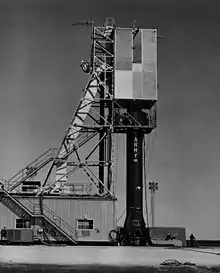Sparta (rocket)
The Sparta (or Redstone Sparta) was a three-stage rocket that launched Australia's first Earth satellite, WRESAT, on 29 November 1967.[1][2][3]
 | |
| Function | Sounding rocket Launch system |
|---|---|
| Manufacturer | ABMA/Chrysler |
| Country of origin | United States |
| Size | |
| Height | 21.8 metres (72 ft) |
| Diameter | 1.78 metres (5 ft 10 in) |
| Mass | 30,000 kilograms (66,000 lb) |
| Stages | 3 |
| Capacity | |
| Payload to LEO | |
| Mass | 45 kilograms (99 lb) |
| Associated rockets | |
| Family | Redstone |
| Comparable | Jupiter-C Juno I |
| Launch history | |
| Status | Retired |
| Launch sites | Woomera Test Range LA-8 |
| Total launches | 10 |
| Success(es) | 9 |
| Failure(s) | 1 |
| First flight | 28 November 1966 |
| Last flight | 29 November 1967 |
| Type of passengers/cargo | Re-entry vehicles, WRESAT |
| First stage – Redstone | |
| Powered by | 1 A-7 |
| Maximum thrust | 416 kilonewtons (94,000 lbf) |
| Specific impulse | 265 sec |
| Burn time | 155 seconds |
| Propellant | LOX/Ethanol |
| Second stage – Antares-2 | |
| Powered by | 1 X-259 |
| Maximum thrust | 93 kilonewtons (21,000 lbf) |
| Specific impulse | 293 sec |
| Burn time | 36 seconds |
| Propellant | Solid |
| Third stage – BE-3 | |
| Powered by | 1 solid |
| Maximum thrust | 34 |
| Burn time | 9 seconds |
| Propellant | Solid |
Sparta used surplus American Redstone rockets as its first stage, a Thiokol Antares-2 as a second stage, and a WRE BE-3 Alcyone solid-propellant engine as a third stage.[2][3]
A first stage was recovered from the Simpson Desert in 1990 after being found in searches by explorer Dick Smith the previous year.[4]: 76–80

Launches
Several Spartas were launched between 1966 and 1967 from Woomera Test Range LA8 in Woomera, South Australia as part of a joint United States–United Kingdom–Australian research program aimed at understanding re-entry phenomena, and the US donated a spare for the scientific satellite launch into polar orbit.[5][2][3]
The first launch was a failure, while the rest were successful.[3]
| Date | Mission Description | Nation | Agency | Apogee (km) |
|---|---|---|---|---|
| 1966 Nov 28 | Sparta SV-1 re-entry vehicle test flight | US | US Army | 90 |
| 1966 Dec 13 | Sparta SV-2 re-entry vehicle test flight | US | US Army | 90 |
| 1967 Apr 20 | Sparta SV-3 re-entry vehicle test flight | US | US Army | 90 |
| 1967 Jul 4 | Sparta SV-4 re-entry vehicle test flight | US | US Army | 90 |
| 1967 Jul 24 | Sparta SV-5 re-entry vehicle test flight | US | US Army | 90 |
| 1967 Aug 17 | Sparta SV-6 re-entry vehicle test flight | US | US Army | 90 |
| 1967 Sep 15 | Sparta SV-7 re-entry vehicle test flight | US | US Army | 91 |
| 1967 Oct 11 | Sparta SV-8 re-entry vehicle test flight | US | US Army | 137 |
| 1967 Oct 31 | Sparta SV-9 re-entry vehicle test flight | US | US Army | 111 |
| 1967 Nov 29 | WRESAT | Australia | WRE | 1252 |
References
- Wade, Mark. "Redstone". Encyclopedia Astronautica.
- Wade, Mark. "SPARTA". Encyclopedia Astronautica. Retrieved 2023-10-16.
- Krebs, Gunter D. "Redstone with solid fuel upper stage". Gunter's Space Page. Retrieved 2023-10-21.
- Dougherty, Kerrie. "Retrieving Woomera's heritage: recovering lost examples of the material culture of Australian space activities" (PDF). Artefacts: Studies in the History of Science and Technology. Vol. 6. p. 80.
- LePage, Andrew J. (May 2, 2011). "Old Reliable: The story of the Redstone". spacereview.com. Retrieved February 7, 2023.